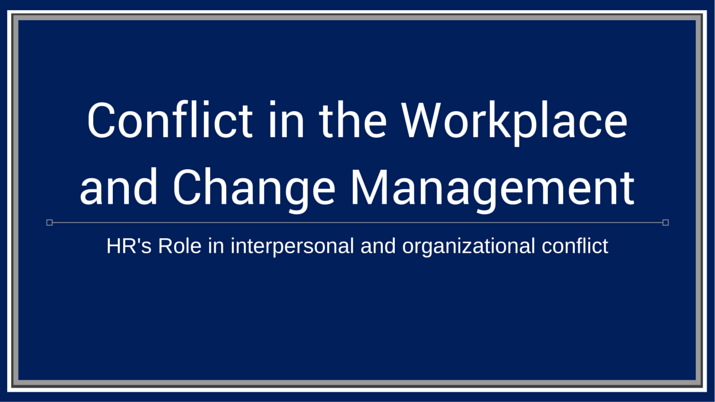Conflict in the Workplace and Change Management: HR’s Role

Last Updated January 12, 2015
Conflict, at some level, is part of the fabric of life in almost any workplace, a function of disparate personalities, interests, styles and expectations. Keeping it manageable can be a challenge, and it falls on HR managers to make sure it happens. This requires recognizing the various sources of conflict and mediating their cause before they erupt into full-blown disputes.
It starts by understanding the two types of conflict that commonly occur in the workplace – interpersonal and organizational.
Ways to manage interpersonal conflict
Interpersonal conflict occurs between individuals, springing from any number of causes, ranging from office politics to personality clashes. Mediators can implement a variety of tactics to help defuse the problem. Among them:
- Encourage people to manage their own responses to the situation. They should figure out why others’ behaviors spark negativity, and then find “stoppers” that will help them avoid reactions that only exacerbate the situation. They should also be encouraged to stop blaming, as it accomplishes nothing.
- Show the way to collaborative problem solving to offset further deterioration in the relationship. Conversations that are fueling the fire, for example, should be stopped until people regain their composure. New behaviors should be practiced in low-risk conversations, not those likely to become incendiary.
- Work with people on ways to focus their energy where it matters and not focus on the problem.
How to defuse organizational conflict
Organizational conflict is most often characterized by issues surrounding hierarchy and conflicting interests, and are prevalent in most workplaces. It can spring from resource allocation, workloads, accountability or any situation where groups of people are not seen to be treated equitably. Several ways to defuse this type of conflict include:
- Ignore the situation. This is acceptable if the underlying issue is trivial and ignoring it will cause less damage than addressing it. If it continues, though, other approaches to defuse the situation follow.
- Often, conflicted parties aren’t listening to the other side so the air can be cleared. A mediator can help by bringing them together and having both sides express their perspectives and try to find a way to common ground.
- Compromise is a solution if parties can come together on aspects driving the conflict that need to be changed versus those that are less important. All sides need to participate in the give and take that compromise means. It’s a means of de-escalating the situation after emotions have been brought under control.
- Sometimes none of these techniques work, requiring a manager or executive to provide a resolution for both sides. Sometimes just the prospect of an enforced resolution will help parties compromise.
How change can drive conflict
Change is a fact of life. In a business setting, it can be caused by growth, pursuing new ventures, management turnover or policy changes. Most people are unsettled by change, however, which gives rise to conflict. The better change is managed, the easier it is to identify potential sources of conflict and step up with solutions before an enforced solution becomes necessary.
This means management must be prepared and positioned to see change coming through monitoring of sales data, marketplace shifts, moves by competitors and relationships with outside organizations. Being on top of these conditions can lead to a more timely response that can keep confidence and morale high as change occurs.
Open communication is also essential. Employees should be informed and kept updated on circumstances causing changes and what is being considered in response. By being transparent and keeping them in the loop, they’ll be less resistant and conflicted by change.
Conflict, its causes and its cures are among the areas of focus for students in a Master’s degree in Human Resources program. Advanced degrees in HR span competencies that are tactical as well as strategic. Learning the latest proven processes and best practices that are driving the HR discipline can position individuals for a rewarding career in the human resources industry.





